KTM’s awesome 500 EXC faces a stiff challenge from Beta’s 520 RS in our Open-class Dual Sport comparison.
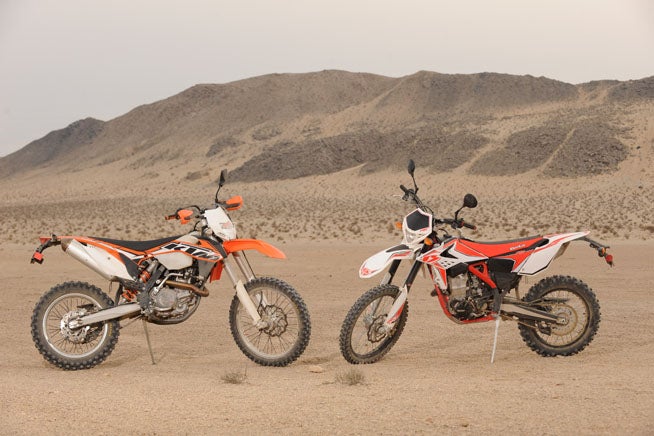
In a day when even large-displacement heavyweight adventure bikes exhibit better handling than some of the bulky single-cylinder dual sport motorcycles of a decade ago, off-road riders seeking a hybrid machine with cutting-edge off-road performance now have solid choices in the Dual Sport marketplace, and the KTM 500 EXC and Beta 520 RS are right at the top of the list.
Born and bred in Austria, KTM’s 500 EXC is widely regarded as the current king of the mountain in the Open dual-sport class. But, Beta, a tiny Italian company with a reputation for building World Championship-winning trials bikes, is now taking heavy swings with some sharp (and sexy) off-road axes in attempt to chop down the Austrian giant in every off-road category where the two compete. Luckily for us, and thanks to the 520 RS, that includes the hard-core dual-sport category.
Euro Powerhouses
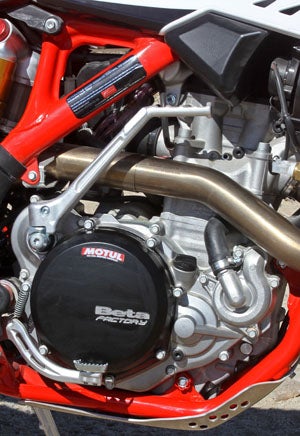
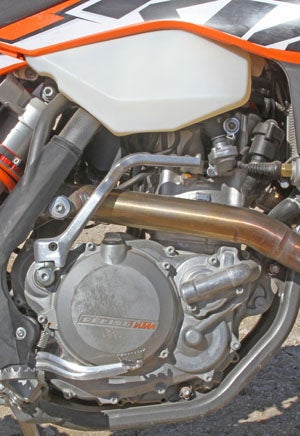
The Beta also features dual oil pumps, but it features separate oil chambers for the crankcase and transmission, while the KTM circulates the same oil through the engine and transmission. Both have smooth-shifting six-speed transmissions, and both come with silky and linear-feeling hydraulic clutches. But these two are miles apart when it comes to their fueling systems. The Beta still uses a good old-fashioned Keihin FC-39 (39mm) carburetor while the KTM sports a more modern Keihin EFI system with a 42mm throttle body.
While there is no malice between the two companies that we know about, each representative politely warned us to watch out for little “tricks” used by the other guy to improve their vehicle’s chances. One manufacturer warned us to make sure that the other’s bike had all of its smog-legal equipment hooked up, while the other pointed to a string of things that its rival is purported to do in order to give its bike the edge. Just goes to show you how close these two machines really are.
Full disclosure: our test KTM 500 EXC was delivered with two deviations from completely stock, and not by our choice. The first was a significant change in gearing that equated to adding six teeth to the rear sprocket to yield shorter gearing than stock. The other change was that KTM’s tech services team took the time to balance the front wheel so it would track more smoothly on high-speed pavement. Our test Beta 520 RS, on the other hand, was stone-stock as far as we could tell, a CARB-legal unit designated for California and complete with the evaporative canister and all of its breather hoses in the right places.
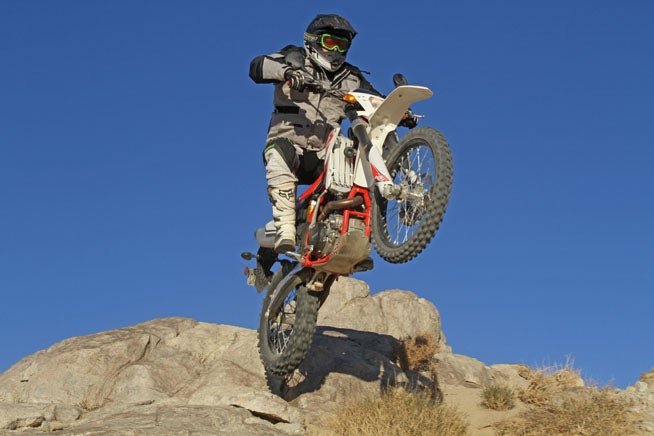
Funny thing, the Beta 520 RS engine turned out to be our favorite of the two whether we were on the trail or on the street. Despite its bigger bore and shorter stroke, its carburetor-fed engine is slightly less responsive and not as quick-revving as the KTM 500 EXC’s, but its power character is smoother overall, with an extremely tractable low-end pull that transitions seamlessly through a potent midrange before gently signing off near the Beta’s 9100-rpm rev limiter. Its brawny pull allows the rider to hold the same gear a long time, even with its tallish stock gearing. In fact, Motorcycle.com Editorial Director Sean Alexander noted that it reminded him of the old Honda XR four-strokes on which he grew up, and we have to agree. Rest assured, the Beta is a whole lot lighter, quicker and more powerful, and it revs much higher than any Honda XR ever did, but the impression only underscores just how the Beta’s heavier-feeling flywheels smooth its power delivery. It is one of the most user-friendly Open-class off-road engines we’ve ever experienced, but it also has an edge to it that’s the hallmark of any good race motor. We really do love it.
The KTM motor is very electric in its power delivery despite being a modern high-winding, state-of-the-art, off-road four-stroke Single. Its flawless fuel-injection gives it a linear and lightning-quick throttle response that is snappier than the Beta’s, and it revs even more quickly, (plus another 500 rpm higher) than the Beta. Yet despite its modified gearing, the KTM didn’t necessarily deliver a more powerful forward lunge when the throttle was cracked open. That’s because the KTM motor’s forte is a broad midrange that transitions seamlessly into its top-end rush. Conversely, its low-end isn’t all that potent-feeling. No wonder KTM delivered it to us with shorter gearing.
Based on our seat-of-the-pants feel, we were convinced that the Beta 520 RS would be the horsepower champion between these two bikes. However, our trip to the dyno, where gearing isn’t a factor, revealed just the opposite. The KTM 500 EXC not only delivered more peak horsepower and torque than the Beta, but its spread of power above 30 lb.-ft. was also broader. The KTM motor churns out 50.2 rear-wheel horsepower at 8,800 rpm with 34.1 ft.-lb. occurring at 7,100 rpm and staying above 30 ft.-lb. from 5,300 rpm all the way to 8,700 rpm. Though slightly down in the numbers game, and 2.5% down in displacement, the Beta compares quite well with the KTM, with 48.2 rear-wheel horsepower at 8,300 rpm and 33.7 ft-lb. of peak torque occurring at 7,400 rpm, while staying above 30 lb.-ft. from 5,800 rpm to 8,400 rpm.
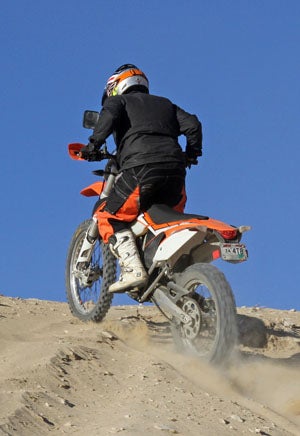
The Beta’s engine is even more superior on the road, thanks to its lower vibration levels. The KTM transmits more buzz through the handlebar, which makes it less comfortable at continuous throttle settings, such as when cruising at 70 mph on the freeway where its lowered gearing forces the revs up. There is a little more zip in the KTM’s motor, but it dosen’t necessarily feel more powerful than the Beta—the KTM’s fuel-injected just engine runs a little cleaner.
Our test crew was unanimous that, while both machines have six-speed transmissions and hydraulically activated clutches, the Beta deserves the nod for its slicker-shifting gearbox. We missed a few shifts on the KTM. We didn’t miss any on the Beta.
Chassis: Which Handles Better?
As good as the Beta engine is, the KTM 500 EXC turns the table when it comes to chassis and handling of these two big-bore dual-sports. Both feature non-perimeter chromoly steel chassis with removable subframes and aluminum swingarms, but their chassis numbers differ slightly.
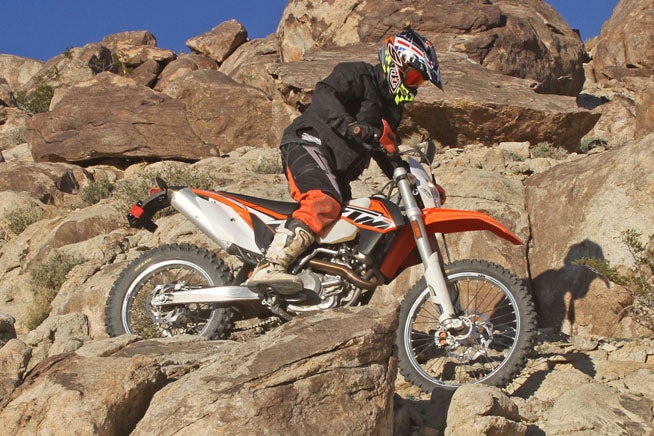
The KTM rides on a 58.3-inch wheelbase and places 48.4% of its 266.4-lb. wet weight, or 128.9 lbs., on its front wheel (give or take a few ounces for KTM’s sneaky wheel balancing job). On the trail, the KTM feels like a featherweight, with effortless, precise turning manners regardless of how rough or loose the terrain. With its 26.5-degree rake and 4.3-inch trail, the KTM requires little more than a nod of the rider’s head to change direction quickly, and it yet remains arrow-stable at high speeds, even on the most whooped-out trails.
Beta has a World Championship-winning heritage when it comes to building trials bikes, so we had no doubt that the 520 RS’s steering would be even more precise than the KTM’s. We were disappointed. The Beta’s wheelbase is only slightly longer, at 58.6 inches, but it’s also nearly 11 lbs. heavier, weighing 277.1 lbs. And while it places less of its weight by percentage on the front wheel, 47.8%, that equates to 132.5 lbs., or 3.6 lbs. more than the KTM. Beta claims a rake of 26.2 degrees and 4.7 inches of trail for the 520’s steering geometry.
Regardless, the 520 RS requires more effort to turn than the KTM. We wouldn’t call it cumbersome, but the extra effort required is especially noticeable when traversing rocky single-track trails or deep desert sand, where the Beta’s front end tends to plow and wander at slower speeds. By contrast, the KTM is laser-like in its steering accuracy at any speed.
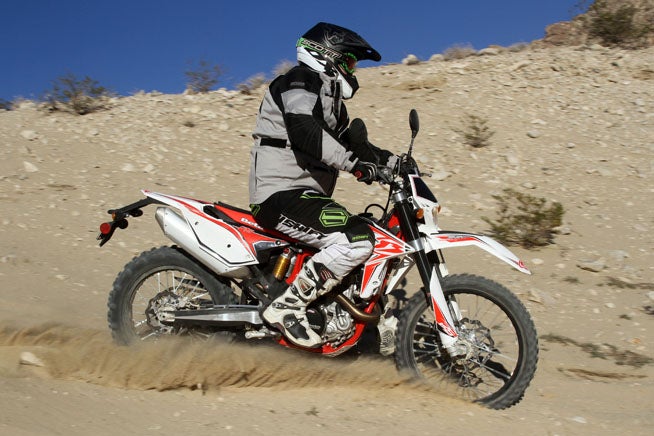
There might be another factor in play here than just steering geometry, however. The Beta’s stock, DOT-legal Michelin Enduro Comp front tire has small and widely spaced knobs that clearly hurt its overall grip on our desert sand test loops.
Of course, the difference is far less noticeable on the street, as both bikes handle like dirtbikes on pavement–or a bit out of their element. Their skinny 21-inch front hoops and DOT knobby tires make them twitchier than the typical streetbike with 17-inch wheels and meaty radials. However, the Beta’s wheelbase and extra front end weight help give it a slightly more planted feel than the KTM.
Both of these machines handle great, but the KTM wins the handling category by virtue of its lighter steering and its capabilities in a wider range of speeds and in more diverse conditions than the Beta.
Suspension Sweepstakes
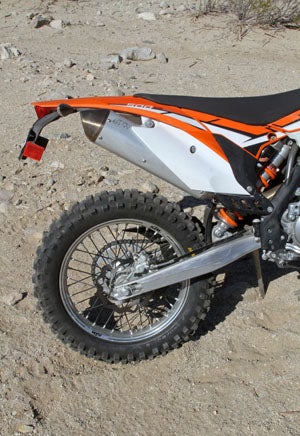
Both of these on/off-road warriors feature 48mm inverted open-cartridge forks clamped in aluminum triple clamps. KTM’s suspension subsidiary, WP, has even more sophisticated closed-cartridge units in its arsenal, but KTM’s North American arm continues to request that the 500 EXC be spec’d with the older open-cartridge units because its R&D team feels that they offer a more supple ride over small bumps than the closed-cartridge forks while not sacrificing control during high-speed G-outs. The 500 EXC’s WP 4860 fork features adjustable compression and rebound damping while delivering 11.8 inches of front wheel travel.
Although its motocross machines have returned to rising-rate linkage rear ends, KTM has practically perfected off-road suspension with its proprietary Progressive Damping System (PDS), and the 500 EXC’s rear end makes use of this non-linkage technology. Its fully adjustable WP 5018 piggyback reservoir monoshock mounts directly to the swingarm and offers 13.2 in. of rear travel, 1.8 inches more than the Beta.
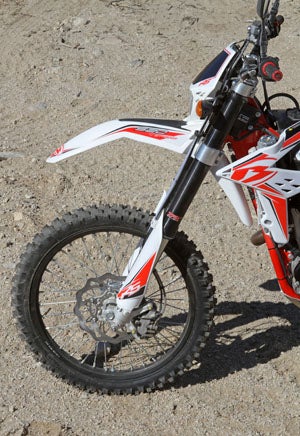
Our testing revealed that dialing in the rear suspension is critical to getting optimum performance and handling out of the front. The Beta’s rear definitely influences its steering to a greater degree than the KTM. As delivered, our 520 RS test bike was set up with 100mm of rear suspension sag with a rider aboard, but that gave it a mushy feel at speed as the rear shock would collapse through big bumps far too easily for our tastes while also making the bike steer like a chopper. Adding preload helped tremendously, bringing the Beta much more level with KTM in terms of overall suspension quality.
But while the Beta’s suspension is very good, it does not yet match the KTM’s overall plushness, especially over smaller bumps and rocks where the KTM delivers a Cadillac ride and cushions big blows, like full compression jump landings or pounding through whoops. And the KTM does so with tremendous composure.
On the street, the Beta’s ride quality is slightly superior to the KTM’s, as its initial stiffness makes it less likely to pogo through road undulations or transfer weight too quickly on acceleration or during braking, but when considering both sides of the fence, dirt and street, the KTM still holds the advantage here.
Brakes and Other Stuff
Both machines feature similar braking hardware, 260mm front and 240mm rear wave rotors clamped by twin-piston front and single-piston rear calipers, and these binders are just another example of the high-quality componentry that abounds on both bikes. The KTM’s brake package is all-Brembo, while the Beta’s brakes are sourced from Nissin (calipers) and Galfer (rotors).
The KTM’s brakes are superb, delivering dirtbike-style braking performance and character on- and off-road. That is to say they’re extremely linear and feel supremely powerful in off-road conditions while at the same time requiring more effort at the lever to approach anything close to a one-G stop on the pavement. They rule in the dirt, yet they’re more than adequate on the street.
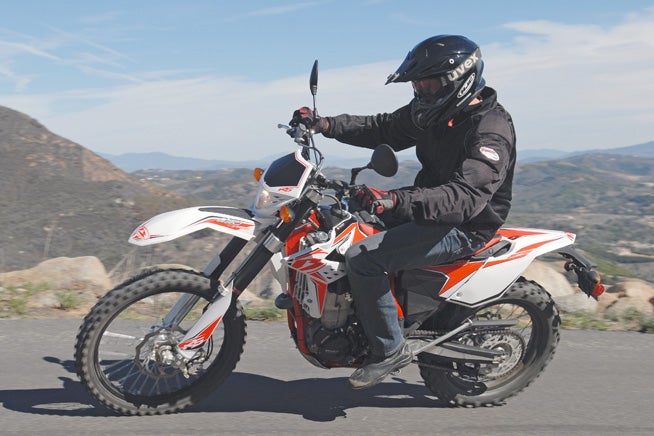
However, street-oriented riders will undoubtedly like the Beta’s braking performance even better than the KTM’s because its front brake has a strong initial bite, while its rear brake is hard to lock up, which practically eliminates the potential for an unwanted skid in the event of a panic stop. But even after we dialed back the leverage at the master cylinder by twisting out the adjuster knob on the Beta’s brake lever – a nice detail, we might add – we weren’t able to get the Beta to match the KTM’s linear feel in the dirt. The Beta’s front brake comes on too strong initially, while its rear brake tends to be rather mushy at the pedal. The Beta’s brakes are good, but the KTM’s are better.
Both bikes also ride on identically sized rims and D.O.T.-legal tires, with 21-inchers up front and 18-inchers out back. At the end of the day, we preferred the KTM’s Maxxis Enduro 90/90-21 front and 140/80-18 rear tires to the same-sized Michelin Enduro Competition tires on the Beta, primarily because the Maxxis tires have larger knobs and tighter lug spacing that offered noticeably superior traction in the California desert.
Couch Potatoes and Video Games
Any time you have a motorcycle saddle that can make a KTM seat feel like a sofa, that’s an issue. Lurking underneath the Beta’s beautiful two-tone red and black seat cover must be the hardest foam in the universe. We experienced severe “numb bum” after just 70 miles in the 520 RS’ saddle. Its sharp-edged contour is also a source of irritation, although we do appreciate the added utility of the small-windowed case at the front of the saddle. Larger riders will appreciate the Beta’s roomy ergonomic layout, while shorter riders will probably also dig its slim feel. The Beta’s 37-inch seat height is also more than an inch lower than the KTM’s 28.1-inch height, which could make a difference when straddling uneven terrain.
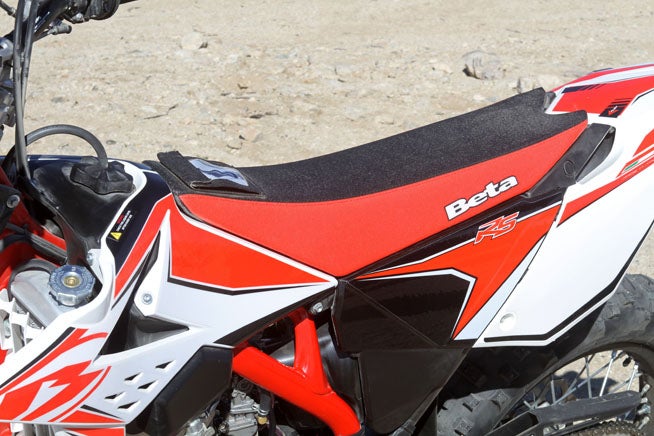
It’s too bad, because, except for its seat, the Beta has a roomier and generally better overall ergonomic feel than the KTM. Its mid-section is a slimmer, and when the rider is standing over the Beta on the pegs, it feels like one of the company’s world-class trials bikes in that there is almost nothing felt between the rider’s legs. Most of our testers also preferred the reach to and the bend of the Beta’s aluminum handlebars more than the KTM’s.
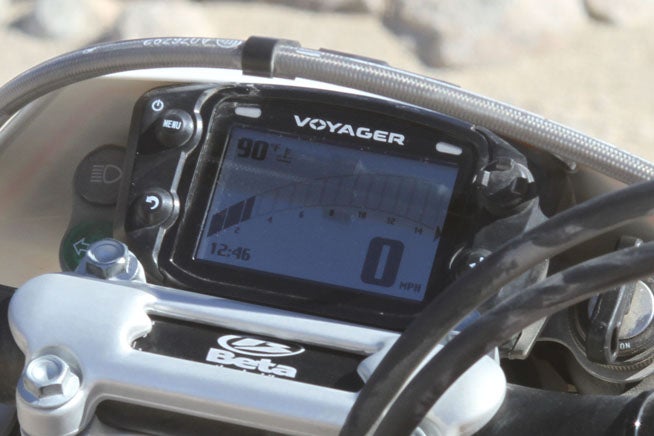
The Beta’s instrumentation blows the KTM’s into the weeds in terms overall cool tech. Betas come equipped with Trail Tech’s awesome Voyager GPS/speedometer unit, which gives the rider a powerful array of functions, including a GPS, speedometer, bar-graph tachometer, tripmeters, clock, engine temperature, compass, altitude, ambient temperature, an hour meter and a volt meter. The Voyager can also readily accept GPX files through a micro SD memory card slot on its right edge, making it easy to download pre-calculated riding routes to its map display. During daytime riding, we appreciated just how easy it was to keep tabs on our speed and trip distance thanks to the Voyager’s large LCD screen. The Beta’s Trail Tech Voyager GPS/instrument panel is one of our favorite highlights on the 520 RS. It’s flat awesome!
The KTM’s compact LCD instrumentation also offers a wealth of functions as well, including a digital speedometer, odometer and tripmeter functions as well as a standard clock and average speed function along with more competition-oriented features such as a lap timer, a mileage meter and a stopwatch function for enduro competition. However, its screen is sensitive to the position of the sun during daytime rides, which sometimes makes it hard to read.
After Dark
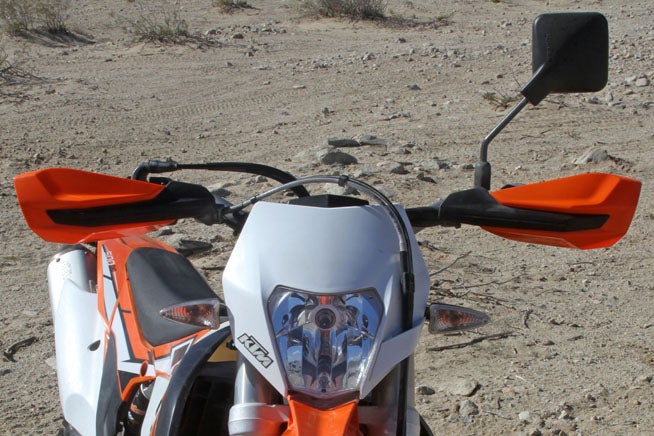
Engaging in a few night rides on both machines, and the KTM’s headlight and taillight are far superior to the Beta’s. The KTM’s headlight/numberplate could stand to be tilted slightly more forward (an easy fix) for even better night vision, its 35/35-watt headlight offers a wider and much brighter field of view than does the Beta’s 60/55-watt headlight. Both machines use sealed LED taillights, but the KTM’s double-row taillight is larger, brighter and much more conspicuous than the tiny single-row unit on the Beta.
Viewing the instrumentation on both bikes at night also revealed a substantial difference in visibility as well. Whereas the KTM’s narrow viewing screen can be difficult to read, the Beta’s Voyager unit is generally easier to see. However, at night the KTM’s screen offers superior backlighting to make monitoring vehicle speed and other functions much easier at a glance than the Voyager display, which isn’t nearly as bright.
A Few Details
When it comes time to gripe, it could be argued that neither of these machines is properly equipped for extreme off-road use. Close, but not quite. The KTM 500 EXC comes standard with excellent handguards, a must for woods riding. The Beta 520 RS doesn’t, but the Beta comes with a durable aluminum skid plate to protect its engine cases and side covers, and the KTM doesn’t. We found this out the hard way as pounding through the rocks left both side covers of our 500 EXC test unit leaking oil, which forced us to dig the JB weld out of our emergency kit and apply a couple splotches before we could ride it again. Both machines offer the respective missing pieces as accessory catalog items, but we have a hard time accepting why they aren’t fitted from the get-go. If forced to choose between the handguards or the skid plate, though, we would rather have the skid plate every time.
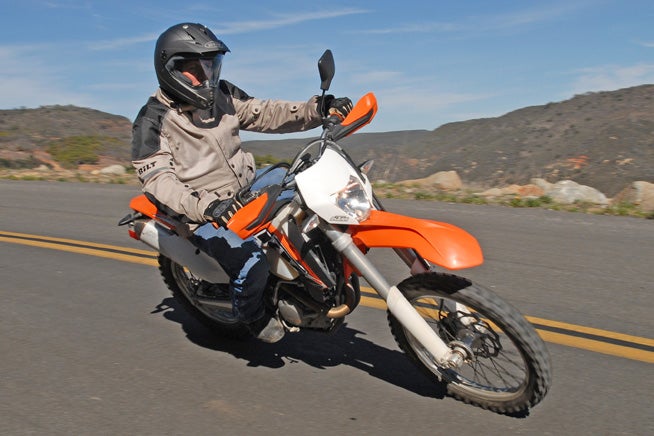
The Beta’s riding enjoyment is interrupted by its smallish 2.1-gallon fuel cell. That might not be so bad if it had EFI for more-precise fuel metering, but our carb’d 520 RS was far thirstier than the fuel-injected KTM, delivering an average of 53.5 mpg for an estimated total range of 112 miles between fill-ups. The Beta is however fitted with a reserve petcock, so at least the rider isn’t completely SOL when it starts gasping for fuel. The KTM’s EFI is paired with a larger 2.4-gallon tank to offer better fuel economy and substantially better range, the 500 EXC averaging 58.1 mpg for an estimated range of 139 miles.
Both machines are equipped with electric start plus a kickstarter for a back-up. We only ever needed to use the kickstarter on the Beta, as its tiny battery balked under the strain of multiple stops and starts while performing a photo shoot out on the trail, leaving us without enough juice to spin the starter.
If this were a beauty contest, the Beta would win, hands-down. The Italian machine screams “Sexy!” and always seemed to draw attention wherever we rode it. There’s just something about that sleek bodywork and stark white with red and black accents and those bright red frame tubes that elevate the heart rate. Face it, the Beta looks as sexy as an Italian beauty queen. Its stylish bodywork and red chassis offer enough visual eye candy to quicken the pulse. If Bimota made dirtbikes, this is what they would look like.
On the other hand, the KTM 500 EXC looks like, well, every other KTM, sort of. The orange, white and black EXC isn’t homely, but it can’t hold a candle to the Beta’s exotic looks. To be fair, KTM places substance over style, but there’s nothing wrong with a little bit of sex appeal, is there?
And The Winner Is…
Beta has worked very hard to bring the 520 RS up to par with the class-leading KTM 500 EXC, and if we were the Austrians, we would start sweating a little. The 520 RS comes very close without mimicking the KTM’s vibe, but it misses the mark by the slimmest of margins. It has an awesome engine, sexy looks, great ergos and value-packed instrumentation, but its suspension and chassis that simply need more refinement if it is going to truly topple the KTM from its throne.
Sure, KTM tried to stack the deck with its unsolicited gearing adjustment, but in the end that didn’t really help the KTM nor hurt the Beta in our judgment. The KTM 500 EXC’s sweet-handling chassis, superior suspension quality and linear brakes are enough to keep it ahead of the slower-handling, stiffer-suspended and heavier Beta 520 RS—for now. Since the two perform similarly on the pavement, albeit with different character, the KTM’s chassis and suspension simply make the difference in the dirt, where it counts, as dirt-riding is the reason most people buy this class of dual-sport in the first place.
The KTM 500 EXC is the not-so-clear winner in this battle, but we love the Beta 520 RS, and have no doubt Beta is going to continue to improve it. If Beta makes the right tweaks to the 520 RS, it will be game on again in 2015.
Specifications
2014 Beta 520 RS
MSRP: $9799
Engine: Liquid-cooled four-stroke single, DOHC four-valve head
Displacement: 497.9cc
Bore x stroke: 100.0 x 63.4mm
Horsepower: 48.2 hp @ 8300 rpm
Torque: 34.1 lb.-ft. @ 7400 rpm
Compression ratio: 12.0:1
Fueling: Keihin FCR 39mm carburetor
Ignition: DC-CD w/variable timing
Clutch: Hydraulically activated clutch
Transmission: Six-speed
Final drive: Chain
Frame type: Chromoly steel w/removable subframe; aluminum swingarm
Front suspension: Inverted Sachs TFX 48mm, adjustable compression and rebound; 11.4 in. of travel
Rear suspension: Sachs fully adjustable monoshock w/piggyback reservoir, 11.4 in. of travel
Front brake: Nissin two-piston caliper w/Galfer 260mm wave-style disc
Rear brake: Nissin single-piston caliper w/Galfer 240mm wave-style disc
Front tire: Michelin Enduro Comp, 90/90-21
Rear tire: Michelin Enduro Comp III, 140/80-18
Wheelbase: 58.7 in.
Rake/trail: 26.2/4.7 in.
Seat height: 37.0 in.
Ground clearance: 12.6 in.
Wet weight: 277.1 lbs.
Fuel capacity: 2.11 gal.
Color: White, Red & Black
2014 KTM 500 EXC
MSRP: $10,099
Engine: Liquid-cooled four-stroke single, SOHC four-valve head
Displacement: 510.4cc
Bore x stroke: 95.0 x 72.0mm
Horsepower: 50.2 hp @ 8800 rpm
Torque: 34.1 lb.-ft. @ 7100 rpm
Compression ratio: 11.8:1
Fueling: Keihin EFI w/42mm throttle body
Ignition: Electronic w/digital adjustment
Clutch: Hydraulically activated DDS (Damped Diaphragm Steel) clutch
Transmission: Six-speed
Final drive: Chain
Frame type: Chromoly steel w/removable subframe; aluminum swingarm
Front suspension: Inverted WP 4860 48mm, adjustable compression and rebound; 11.8 in. of travel
Rear suspension: WP 5018, fully adjustable monoshock w/piggyback reservoir, 13.2 in. of travel
Front brake: Brembo two-piston caliper w/260mm wave-style disc
Rear brake: Brembo single-piston caliper w/240mm wave-style disc
Front tire: Maxxis Enduro 90/90-21
Rear tire: Maxxis Enduro 140/80-18
Wheelbase: 58.4 in.
Rake/trail: 26.5/4.3 in.
Seat height: 38.1 in.
Ground clearance: 13.6 in.
Wet weight: 266.4 lbs.
Fuel capacity: 2.4 gal.
Color: Orange, White & Black
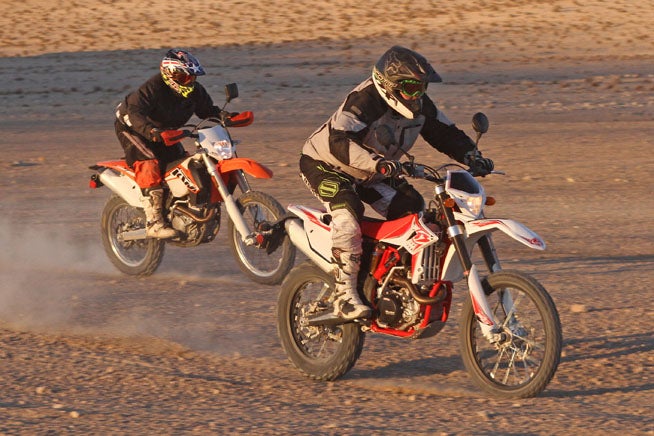
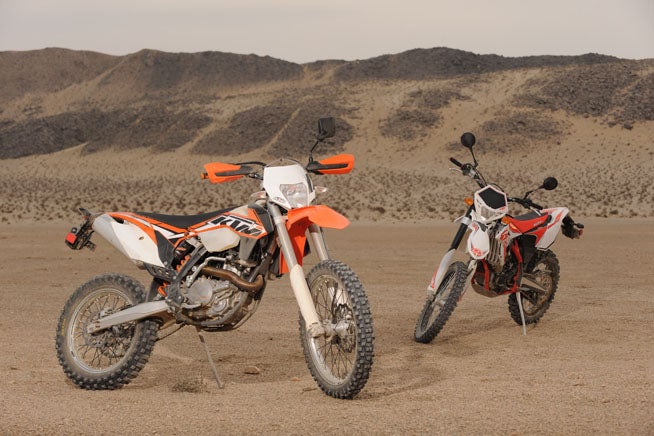
 Your Privacy Choices
Your Privacy Choices